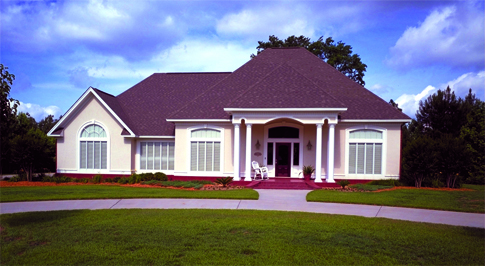
Concrete Homes: Strong, Versatile and Durable
Concrete homes offer features that purchasers and builders value; strong and solid construction that provides comfortable shelter from typical weather, and minimizes property damage while protecting occupants from extreme weather and natural disasters. Yet strength and durability alone are not enough: the systems have to be easy to design and build and be versatile to suit any architectural style. Concrete systems are that and more.
Environmental Benefits During Construction
Locally Sourced Materials. The manufacturing process of portland cement, the binding element of concrete, is not tied to a certain region of the country and the materials involved in the process are readily available throughout North America.
Use of Recycled Components. Concrete walls can incorporate recycled supplementary cementitious materials like fly ash and slag cement in two ways. First, portland cement is often produced by including recycled industrial byproducts such fly ash into the manufacturing process to minimize dependence on virgin raw materials. Additionally, fly ash, slag cement, silica fume, and recycled aggregates can be incorporated into concrete, thereby diverting materials from the landfill and reducing use of natural resources.
During the Life of the Structure
Cool. Light- or natural-colored concrete reduces heat islands, thereby lowering outdoor temperatures, saving energy, and reducing smog.
Disaster Resistant. Concrete walls offer high durability and strength They are resistant to fires, wind, hurricanes, floods, earthquakes, wind-driven rain, and moisture damage. The use of concrete can even reduce fire insurance rates. Read more on Resilient Construction.
Energy Performance. Houses constructed with concrete achieve energy savings by combining the thermal mass of concrete with the optimal amount of insulation in precast concrete walls. Compared to wood and steel, concrete structures allow minimal temperature fluctuations. Consequently, heating, ventilating, and air-conditioning can be designed with smaller-capacity equipment, saving money and resources. Additionally the wall acts as an air barrier, reducing air infiltration and saving more energy.
Indoor Air Quality. Concrete has low volatile organic compound (VOC) emittance and does not degrade indoor air quality.
Recyclable. Concrete structures in urban areas can be recycled into fill and road base material at the end of their useful life (about 5 to 20 percent of aggregate in precast concrete can be recycled concrete).
Concrete Home Advantages
 When I'm at home, I want peace and quiet. My concrete home keeps things quiet. I can't hear the neighbor's lawn mowers and my floors don't squeak. That's why I chose concrete walls, floors and roof of my new home.
When I'm at home, I want peace and quiet. My concrete home keeps things quiet. I can't hear the neighbor's lawn mowers and my floors don't squeak. That's why I chose concrete walls, floors and roof of my new home.
Not only that but my architect was able to create longer floor spans using concrete for a more open feel. She was able to use many different finish materials - hardwood, tile, and carpet. I told her I wanted something spectacular in the entrance - so she used color and texture cast into the concrete to give the look of stone.
And I can rest easier knowing that my concrete home provides additional protection against the ravages of Mother Nature - tornadoes, hurricanes, earthquakes, fire, rot, and pests. The mass of the concrete and air tightness translates into energy savings too. My home stays warmer in the winter and cooler in the summer. I put a radiant heating system into the concrete floor which provides me with even more comfort and savings. With low maintenance year after year, concrete was the most economical and worry free choice.
There's just no limit to the beauty of concrete.